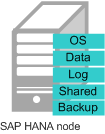Introduction
This document describes how to deploy SAP Business One (SAP HANA as the database).
The document conventions are as follows:
- This document describes how to install and deploy SAP Business One (SAP HANA as the database).
- This document cannot replace the standard SAP document. If you have any trouble in installing and using SAP Business One due to its own problems, contact the SAP technical support.
- This document is written based on the OS SUSE Linux Enterprise Server. The deployment modes mentioned in the document are only for reference. Install SAP Business One by referring to the standard SAP installation manual or based on sizing results and site requirements.
- For details about the official SAP installation guide and related notes, see the following documents:
Introduction to SAP Business One
SAP Business One is an ERP software designed by SAP to meet the ever-changing requirements of small and medium-sized enterprises. It is a service management software that can be scaled up along with enterprise development.
Based on deployment and O&M modes, SAP Business One products include traditional Business One, Business One Cloud, and Business One OnDemand.
- Traditional Business One: is deployed by enterprises.
- Business One Cloud: is provided in the form of SaaS on public cloud.
- Business One OnDemand: is provided in the form of SaaS by SAP hosting providers.
Based on database types, SAP Business One products include B1, B1A, and B1H.
- B1: uses traditional non-HANA databases.
- B1A: The analysis part of Business One uses HANA databases for acceleration, but the application part still uses traditional databases for data replication.
- B1H: Business One uses the HANA database. In this way, OLTP and OLAP are processed in the same database to achieve the best performance.
SAP Business One and Public Cloud Services
- Elastic Cloud Server (ECS)
An ECS is an elastically scalable computing server that consists of CPU, memory, images, and EVS disks. An ECS can be obtained at any time and provides various services and functions, such as VPC, virtual firewall, and multiple copies of data storage. SAP Business One, NAT server, SAP Business One Client, and SAP HANA Studio are deployed on ECSs.
- Virtual Private Cloud (VPC)
All ECSs in SAP Business One scenarios belong to the same VPC. They are isolated using VPC subnets and network groups for network security.
- Image Management Service (IMS)
When creating an ECS, select a proper public image, for example, SUSE Linux Enterprise Server (SLES) 11 SP4.
- Scalable File Service (SFS)
SFS provides high-performance file storage that is scalable on demand. It can be shared with multiple cloud servers. Backup volumes of the SAP HANA database are provided by SFS.
Node and Role
- SAP Business One
SAP Business One is an ERP software designed by SAP to meet the ever-changing requirements of small and medium-sized enterprises. It is a service management software that can be scaled up along with enterprise development.
- SAP HANA
An SAP HANA system consists of one or multiple SAP HANA nodes.
SAP HANA nodes are logical units that constitute an SAP HANA system. An SAP HANA node contains the CPU, memory, and storage (such as log, data, shared, and backup disks) resources with specified specifications, as shown in Figure 1.
- SAP HANA Studio
The SAP HANA Studio provides management, monitoring, and information modeling of the SAP HANA system. It can also function as a client and provides capabilities to access user data. The information that the SAP HANA Studio provides includes the system information (such as software version), alarm information (generated by Statistics Server), and statistics of key system resources.
- SAP Business One Client
- NAT Server
A Network Address Translation (NAT) server provides the capability to switch to SAP nodes using SSH. It allows you to switch to an SAP node from the NAT server using Secure Shell (SSH).
Feedback
Was this page helpful?
Provide feedbackThank you very much for your feedback. We will continue working to improve the documentation.See the reply and handling status in My Cloud VOC.
For any further questions, feel free to contact us through the chatbot.
Chatbot






